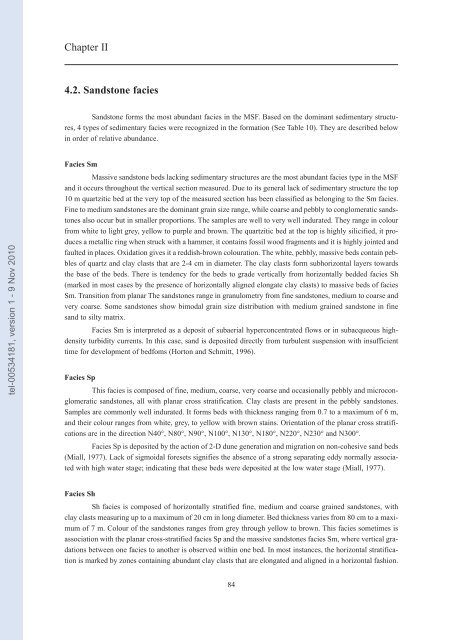Etude stratigraphique, pétrographique et diagénétique des grès d ...
Etude stratigraphique, pétrographique et diagénétique des grès d ...
Etude stratigraphique, pétrographique et diagénétique des grès d ...
You also want an ePaper? Increase the reach of your titles
YUMPU automatically turns print PDFs into web optimized ePapers that Google loves.
tel-00534181, version 1 - 9 Nov 2010<br />
Chapter II<br />
4.2. Sandstone facies<br />
Sandstone forms the most abundant facies in the MSF. Based on the dominant sedimentary structures,<br />
4 types of sedimentary facies were recognized in the formation (See Table 10). They are <strong>des</strong>cribed below<br />
in order of relative abundance.<br />
Facies Sm<br />
Massive sandstone beds lacking sedimentary structures are the most abundant facies type in the MSF<br />
and it occurs throughout the vertical section measured. Due to its general lack of sedimentary structure the top<br />
10 m quartzitic bed at the very top of the measured section has been classified as belonging to the Sm facies.<br />
Fine to medium sandstones are the dominant grain size range, while coarse and pebbly to conglomeratic sandstones<br />
also occur but in smaller proportions. The samples are well to very well indurated. They range in colour<br />
from white to light grey, yellow to purple and brown. The quartzitic bed at the top is highly silicified, it produces<br />
a m<strong>et</strong>allic ring when struck with a hammer, it contains fossil wood fragments and it is highly jointed and<br />
faulted in places. Oxidation gives it a reddish-brown colouration. The white, pebbly, massive beds contain pebbles<br />
of quartz and clay clasts that are 2-4 cm in diam<strong>et</strong>er. The clay clasts form subhorizontal layers towards<br />
the base of the beds. There is tendency for the beds to grade vertically from horizontally bedded facies Sh<br />
(marked in most cases by the presence of horizontally aligned elongate clay clasts) to massive beds of facies<br />
Sm. Transition from planar The sandstones range in granulom<strong>et</strong>ry from fine sandstones, medium to coarse and<br />
very coarse. Some sandstones show bimodal grain size distribution with medium grained sandstone in fine<br />
sand to silty matrix.<br />
Facies Sm is interpr<strong>et</strong>ed as a deposit of subaerial hyperconcentrated flows or in subacqueous highdensity<br />
turbidity currents. In this case, sand is deposited directly from turbulent suspension with insufficient<br />
time for development of bedfoms (Horton and Schmitt, 1996).<br />
Facies Sp<br />
This facies is composed of fine, medium, coarse, very coarse and occasionally pebbly and microconglomeratic<br />
sandstones, all with planar cross stratification. Clay clasts are present in the pebbly sandstones.<br />
Samples are commonly well indurated. It forms beds with thickness ranging from 0.7 to a maximum of 6 m,<br />
and their colour ranges from white, grey, to yellow with brown stains. Orientation of the planar cross stratifications<br />
are in the direction N40°, N80°, N90°, N100°, N130°, N180°, N220°, N230° and N300°.<br />
Facies Sp is deposited by the action of 2-D dune generation and migration on non-cohesive sand beds<br />
(Miall, 1977). Lack of sigmoidal fores<strong>et</strong>s signifies the absence of a strong separating eddy normally associated<br />
with high water stage; indicating that these beds were deposited at the low water stage (Miall, 1977).<br />
Facies Sh<br />
Sh facies is composed of horizontally stratified fine, medium and coarse grained sandstones, with<br />
clay clasts measuring up to a maximum of 20 cm in long diam<strong>et</strong>er. Bed thickness varies from 80 cm to a maximum<br />
of 7 m. Colour of the sandstones ranges from grey through yellow to brown. This facies som<strong>et</strong>imes is<br />
association with the planar cross-stratified facies Sp and the massive sandstones facies Sm, where vertical gradations<br />
b<strong>et</strong>ween one facies to another is observed within one bed. In most instances, the horizontal stratification<br />
is marked by zones containing abundant clay clasts that are elongated and aligned in a horizontal fashion.<br />
84

















